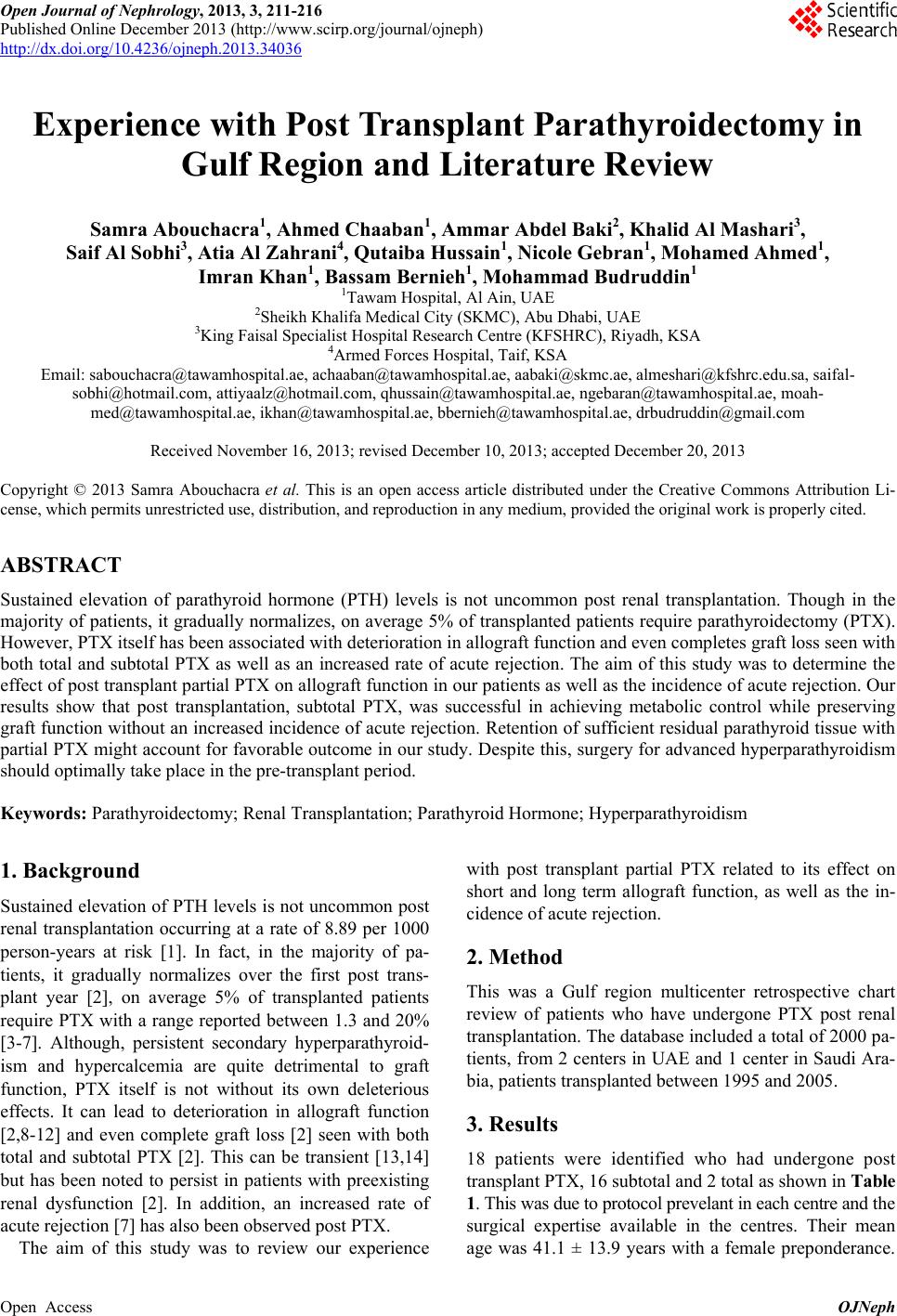 Open Journal of Nephrology, 2013, 3, 211-216 Published Online December 2013 (http://www.scirp.org/journal/ojneph) http://dx.doi.org/10.4236/ojneph.2013.34036 Open Access OJNeph Experience with Post Transplant Parathyroidectomy in Gulf Region and Literature Review Samra Abouchacra1, Ahmed Chaaban1, Ammar Abdel Baki2, Khalid Al Mashari3, Saif Al Sobhi3, Atia Al Zahrani4, Qutaiba Hussain1, Nicole Gebran1, Mohamed Ahmed1, Imran Khan1, Bassam Bernieh1, Mohammad Budruddin1 1Tawam Hospital, Al Ain, UAE 2Sheikh Khalifa Medical City (SKMC), Abu Dhabi, UAE 3King Faisal Specialist Hospital Research Centre (KFSHRC), Riyadh, KSA 4Armed Forces Hospital, Taif, KSA Email: sabouchacra@tawamhospital.ae, achaaban@tawamhospital.ae, aabaki@skmc.ae, almeshari@kfshrc.edu.sa, saifal- sobhi@hotmail.com, attiyaalz@hotmail.com, qhussain@tawamhospital.ae, ngebaran@tawamhospital.ae, moah- med@tawamhospital.ae, ikhan@tawamhospital.ae, bbernieh@tawamhospital.ae, drbudruddin@gmail.com Received November 16, 2013; revised December 10, 2013; accepted December 20, 2013 Copyright © 2013 Samra Abouchacra et al. This is an open access article distributed under the Creative Commons Attribution Li- cense, which permits unrestricted use, distribution, and reproduction in any medium, provided the original work is properly cited. ABSTRACT Sustained elevation of parathyroid hormone (PTH) levels is not uncommon post renal transplantation. Though in the majority of patients, it gradually normalizes, on average 5% of transplanted patients require parathyroidectomy (PTX). However, PTX itself has been associated with deterioration in allograft function and even completes graft loss seen with both total and subtotal PTX as well as an increased rate of acute rejection. The aim of this study was to determine the effect of post transplant partial PTX on allograft function in our patients as well as the incidence of acute rejection. Our results show that post transplantation, subtotal PTX, was successful in achieving metabolic control while preserving graft function without an increased incidence of acute rejection. Retention of sufficient residual parathyroid tissue with partial PTX might account for favorable outcome in our study. Despite this, surgery for advanced hyperparathyroidism should optimally take place in the pre-transplant period. Keywords: Parathyroidectomy; Renal Transplantation; Parathyroid Hormone; Hyperparathyroidism 1. Background Sustained elevation of PTH levels is not uncommon post renal transplantation occurring at a rate of 8.89 per 1000 person-years at risk [1]. In fact, in the majority of pa- tients, it gradually normalizes over the first post trans- plant year [2], on average 5% of transplanted patients require PTX with a range reported between 1.3 and 20% [3-7]. Although, persistent secondary hyperparathyroid- ism and hypercalcemia are quite detrimental to graft function, PTX itself is not without its own deleterious effects. It can lead to deterioration in allograft function [2,8-12] and even complete graft loss [2] seen with both total and subtotal PTX [2]. This can be transient [13,14] but has been noted to persist in patients with preexisting renal dysfunction [2]. In addition, an increased rate of acute rejection [7] has also been observed post PTX. The aim of this study was to review our experience with post transplant partial PTX related to its effect on short and long term allograft function, as well as the in- cidence of acute rejection. 2. Method This was a Gulf region multicenter retrospective chart review of patients who have undergone PTX post renal transplantation. The database included a total of 2000 pa- tients, from 2 centers in UAE and 1 center in Saudi Ara- bia, patients transplanted between 1995 and 2005. 3. Results 18 patients were identified who had undergone post transplant PTX, 16 subtotal and 2 total as shown in Table 1. This was due to protocol prevelant in each centre and the surgical expertise available in the centres. Their mean ge was 41.1 ± 13.9 years with a female preponderance. a 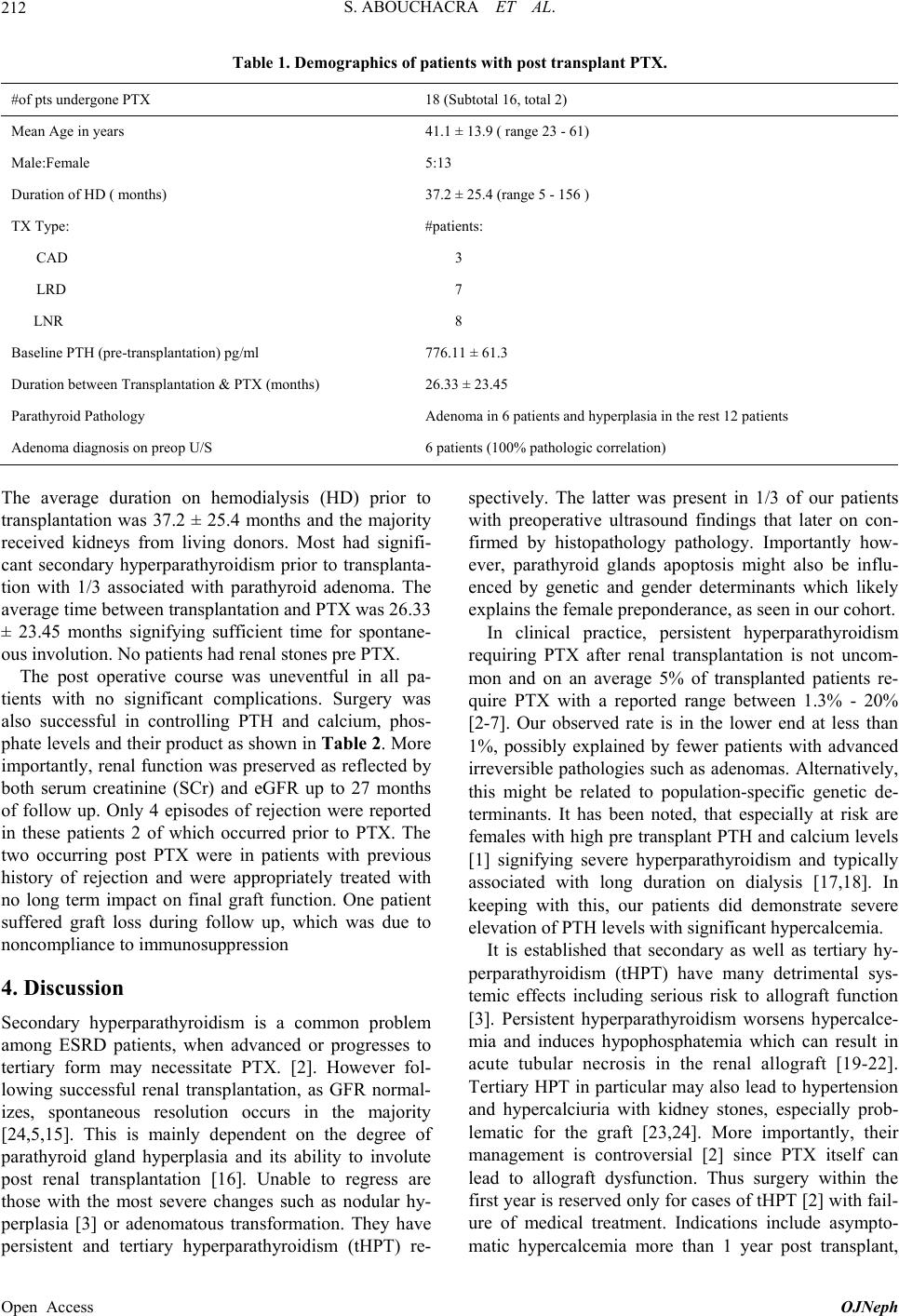 S. ABOUCHACRA ET AL. 212 Table 1. Demographics of patients with post transplant PTX. #of pts undergone PTX 18 (Subtotal 16, total 2) Mean Age in years 41.1 ± 13.9 ( range 23 - 61) Male:Female 5:13 Duration of HD ( months) 37.2 ± 25.4 (range 5 - 156 ) TX Type: #patients: CAD 3 LRD 7 LNR 8 Baseline PTH (pre-transplantation) pg/ml 776.11 ± 61.3 Duration between Transplantation & PTX (months) 26.33 ± 23.45 Parathyroid Pathology Adenoma in 6 patients and hyperplasia in the rest 12 patients Adenoma diagnosis on preop U/S 6 patients (100% pathologic correlation) The average duration on hemodialysis (HD) prior to transplantation was 37.2 ± 25.4 months and the majority received kidneys from living donors. Most had signifi- cant secondary hyperparathyroidism prior to transplanta- tion with 1/3 associated with parathyroid adenoma. The average time between transplantation and PTX was 26.33 ± 23.45 months signifying sufficient time for spontane- ous involution. No patients had renal stones pre PTX. The post operative course was uneventful in all pa- tients with no significant complications. Surgery was also successful in controlling PTH and calcium, phos- phate levels and their product as shown in Table 2. More importantly, renal function was preserved as reflected by both serum creatinine (SCr) and eGFR up to 27 months of follow up. Only 4 episodes of rejection were reported in these patients 2 of which occurred prior to PTX. The two occurring post PTX were in patients with previous history of rejection and were appropriately treated with no long term impact on final graft function. One patient suffered graft loss during follow up, which was due to noncompliance to immunosuppression 4. Discussion Secondary hyperparathyroidism is a common problem among ESRD patients, when advanced or progresses to tertiary form may necessitate PTX. [2]. However fol- lowing successful renal transplantation, as GFR normal- izes, spontaneous resolution occurs in the majority [24,5,15]. This is mainly dependent on the degree of parathyroid gland hyperplasia and its ability to involute post renal transplantation [16]. Unable to regress are those with the most severe changes such as nodular hy- perplasia [3] or adenomatous transformation. They have persistent and tertiary hyperparathyroidism (tHPT) re- spectively. The latter was present in 1/3 of our patients with preoperative ultrasound findings that later on con- firmed by histopathology pathology. Importantly how- ever, parathyroid glands apoptosis might also be influ- enced by genetic and gender determinants which likely explains the female preponderance, as seen in our cohort. In clinical practice, persistent hyperparathyroidism requiring PTX after renal transplantation is not uncom- mon and on an average 5% of transplanted patients re- quire PTX with a reported range between 1.3% - 20% [2-7]. Our observed rate is in the lower end at less than 1%, possibly explained by fewer patients with advanced irreversible pathologies such as adenomas. Alternatively, this might be related to population-specific genetic de- terminants. It has been noted, that especially at risk are females with high pre transplant PTH and calcium levels [1] signifying severe hyperparathyroidism and typically associated with long duration on dialysis [17,18]. In keeping with this, our patients did demonstrate severe elevation of PTH levels with significant hypercalcemia. It is established that secondary as well as tertiary hy- perparathyroidism (tHPT) have many detrimental sys- temic effects including serious risk to allograft function [3]. Persistent hyperparathyroidism worsens hypercalce- mia and induces hypophosphatemia which can result in acute tubular necrosis in the renal allograft [19-22]. Tertiary HPT in particular may also lead to hypertension and hypercalciuria with kidney stones, especially prob- lematic for the graft [23,24]. More importantly, their management is controversial [2] since PTX itself can lead to allograft dysfunction. Thus surgery within the first year is reserved only for cases of tHPT [2] with fail- ure of medical treatment. Indications include asympto- atic hypercalcemia more than 1 year post transplant, m Open Access OJNeph 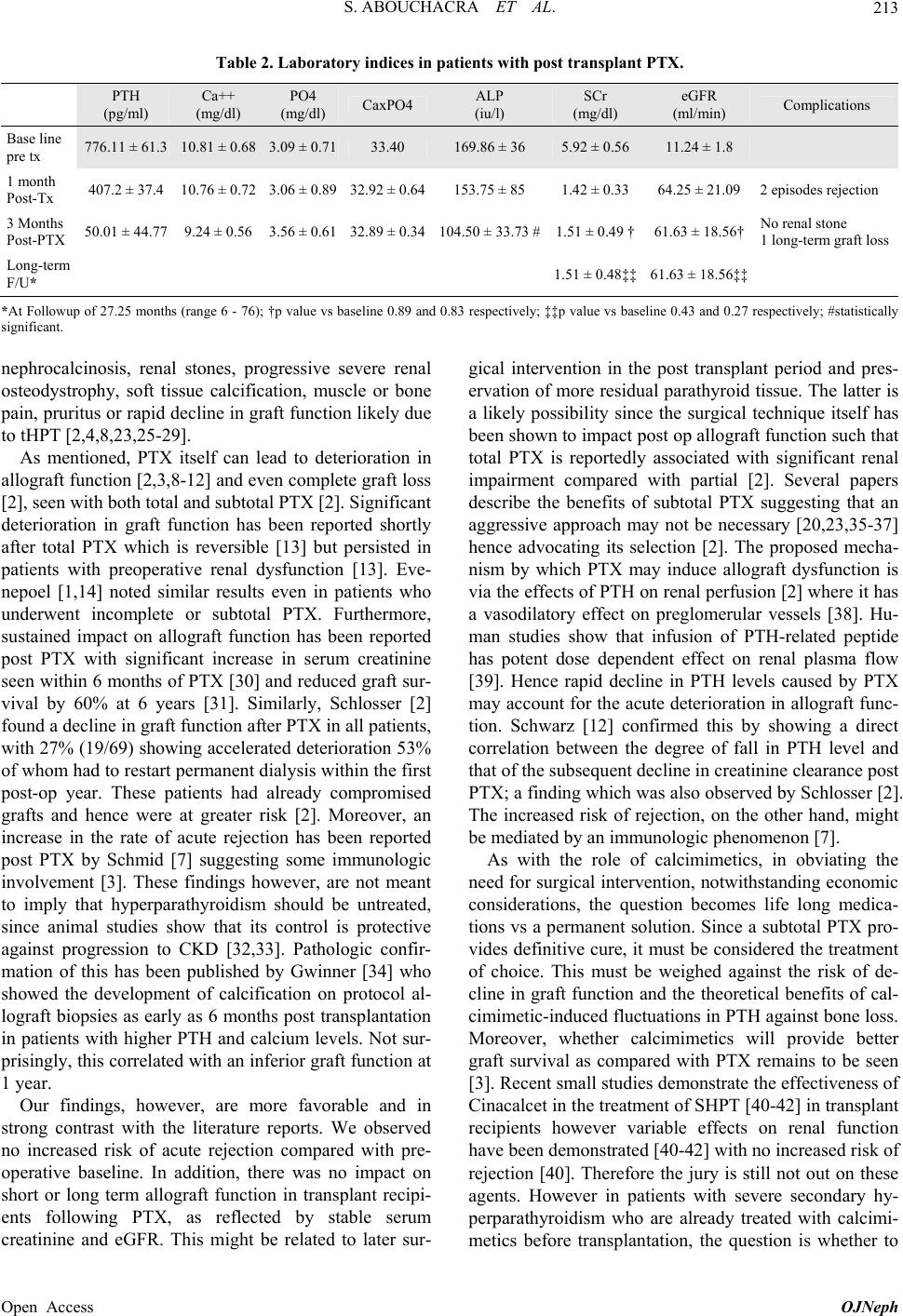 S. ABOUCHACRA ET AL. 213 Table 2. Laboratory indices in patients with post transplant PTX. PTH (pg/ml) Ca++ (mg/dl) PO4 (mg/dl) CaxPO4 ALP (iu/l) SCr (mg/dl) eGFR (ml/min) Complications Base line pre tx 776.11 ± 61.3 10.81 ± 0.68 3.09 ± 0.71 33.40 169.86 ± 36 5.92 ± 0.5611.24 ± 1.8 1 month Post-Tx 407.2 ± 37.4 10.76 ± 0.72 3.06 ± 0.89 32.92 ± 0.64153.75 ± 85 1.42 ± 0.3364.25 ± 21.09 2 episodes rejection 3 Months Post-PTX 50.01 ± 44.77 9.24 ± 0.56 3.56 ± 0.61 32.89 ± 0.34104.50 ± 33.73 #1.51 ± 0.49 †61.63 ± 18.56† No renal stone 1 long-term graft loss Long-term F/U* 1.51 ± 0.48‡‡61.63 ± 18.56‡‡ *At Followup of 27.25 months (range 6 - 76); †p value vs baseline 0.89 and 0.83 respectively; ‡‡p value vs baseline 0.43 and 0.27 respectively; #statistically significant. nephrocalcinosis, renal stones, progressive severe renal osteodystrophy, soft tissue calcification, muscle or bone pain, pruritus or rapid decline in graft function likely due to tHPT [2,4,8,23,25-29]. As mentioned, PTX itself can lead to deterioration in allograft function [2,3,8-12] and even complete graft loss [2], seen with both total and subtotal PTX [2]. Significant deterioration in graft function has been reported shortly after total PTX which is reversible [13] but persisted in patients with preoperative renal dysfunction [13]. Eve- nepoel [1,14] noted similar results even in patients who underwent incomplete or subtotal PTX. Furthermore, sustained impact on allograft function has been reported post PTX with significant increase in serum creatinine seen within 6 months of PTX [30] and reduced graft sur- vival by 60% at 6 years [31]. Similarly, Schlosser [2] found a decline in graft function after PTX in all patients, with 27% (19/69) showing accelerated deterioration 53% of whom had to restart permanent dialysis within the first post-op year. These patients had already compromised grafts and hence were at greater risk [2]. Moreover, an increase in the rate of acute rejection has been reported post PTX by Schmid [7] suggesting some immunologic involvement [3]. These findings however, are not meant to imply that hyperparathyroidism should be untreated, since animal studies show that its control is protective against progression to CKD [32,33]. Pathologic confir- mation of this has been published by Gwinner [34] who showed the development of calcification on protocol al- lograft biopsies as early as 6 months post transplantation in patients with higher PTH and calcium levels. Not sur- prisingly, this correlated with an inferior graft function at 1 year. Our findings, however, are more favorable and in strong contrast with the literature reports. We observed no increased risk of acute rejection compared with pre- operative baseline. In addition, there was no impact on short or long term allograft function in transplant recipi- ents following PTX, as reflected by stable serum creatinine and eGFR. This might be related to later sur- gical intervention in the post transplant period and pres- ervation of more residual parathyroid tissue. The latter is a likely possibility since the surgical technique itself has been shown to impact post op allograft function such that total PTX is reportedly associated with significant renal impairment compared with partial [2]. Several papers describe the benefits of subtotal PTX suggesting that an aggressive approach may not be necessary [20,23,35-37] hence advocating its selection [2]. The proposed mecha- nism by which PTX may induce allograft dysfunction is via the effects of PTH on renal perfusion [2] where it has a vasodilatory effect on preglomerular vessels [38]. Hu- man studies show that infusion of PTH-related peptide has potent dose dependent effect on renal plasma flow [39]. Hence rapid decline in PTH levels caused by PTX may account for the acute deterioration in allograft func- tion. Schwarz [12] confirmed this by showing a direct correlation between the degree of fall in PTH level and that of the subsequent decline in creatinine clearance post PTX; a finding which was also observed by Schlosser [2]. The increased risk of rejection, on the other hand, might be mediated by an immunologic phenomenon [7]. As with the role of calcimimetics, in obviating the need for surgical intervention, notwithstanding economic considerations, the question becomes life long medica- tions vs a permanent solution. Since a subtotal PTX pro- vides definitive cure, it must be considered the treatment of choice. This must be weighed against the risk of de- cline in graft function and the theoretical benefits of cal- cimimetic-induced fluctuations in PTH against bone loss. Moreover, whether calcimimetics will provide better graft survival as compared with PTX remains to be seen [3]. Recent small studies demonstrate the effectiveness of Cinacalcet in the treatment of SHPT [40-42] in transplant recipients however variable effects on renal function have been demonstrated [40-42] with no increased risk of rejection [40]. Therefore the jury is still not out on these agents. However in patients with severe secondary hy- perparathyroidism who are already treated with calcimi- metics before transplantation, the question is whether to Open Access OJNeph 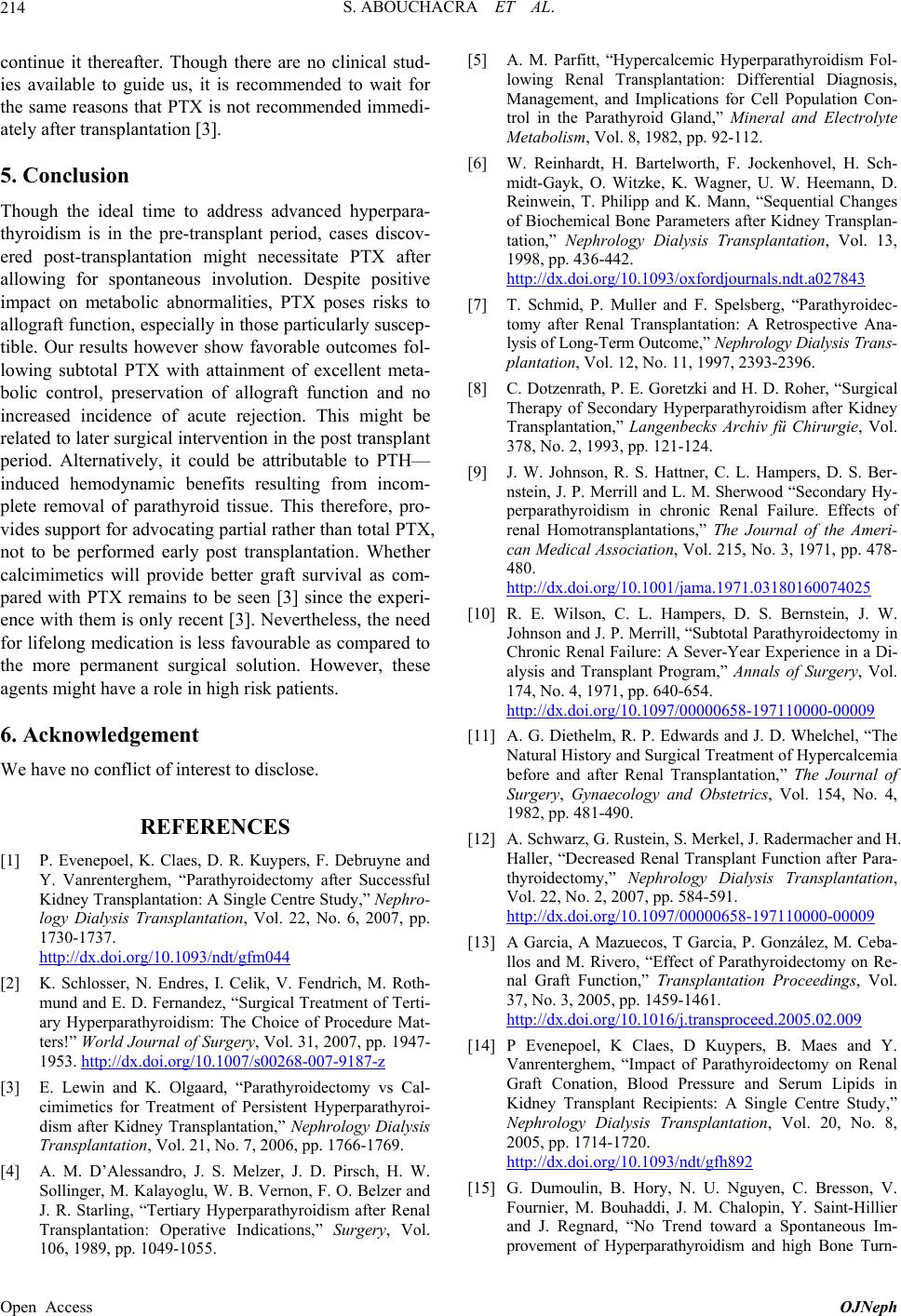 S. ABOUCHACRA ET AL. 214 continue it thereafter. Though there are no clinical stud- ies available to guide us, it is recommended to wait for the same reasons that PTX is not recommended immedi- ately after transplantation [3]. 5. Conclusion Though the ideal time to address advanced hyperpara- thyroidism is in the pre-transplant period, cases discov- ered post-transplantation might necessitate PTX after allowing for spontaneous involution. Despite positive impact on metabolic abnormalities, PTX poses risks to allograft function, especially in those particularly suscep- tible. Our results however show favorable outcomes fol- lowing subtotal PTX with attainment of excellent meta- bolic control, preservation of allograft function and no increased incidence of acute rejection. This might be related to later surgical intervention in the post transplant period. Alternatively, it could be attributable to PTH— induced hemodynamic benefits resulting from incom- plete removal of parathyroid tissue. This therefore, pro- vides support for advocating partial rather than total PTX, not to be performed early post transplantation. Whether calcimimetics will provide better graft survival as com- pared with PTX remains to be seen [3] since the experi- ence with them is only recent [3]. Nevertheless, the need for lifelong medication is less favourable as compared to the more permanent surgical solution. However, these agents might have a role in high risk patients. 6. Acknowledgement We have no conflict of interest to disclose. REFERENCES [1] P. Evenepoel, K. Claes, D. R. Kuypers, F. Debruyne and Y. Vanrenterghem, “Parathyroidectomy after Successful Kidney Transplantation: A Single Centre Study,” Nephro- logy Dialysis Transplantation, Vol. 22, No. 6, 2007, pp. 1730-1737. http://dx.doi.org/10.1093/ndt/gfm044 [2] K. Schlosser, N. Endres, I. Celik, V. Fendrich, M. Roth- mund and E. D. Fernandez, “Surgical Treatment of Terti- ary Hyperparathyroidism: The Choice of Procedure Mat- ters!” World Journal of Surgery, Vol. 31, 2007, pp. 1947- 1953. http://dx.doi.org/10.1007/s00268-007-9187-z [3] E. Lewin and K. Olgaard, “Parathyroidectomy vs Cal- cimimetics for Treatment of Persistent Hyperparathyroi- dism after Kidney Transplantation,” Nephrology Dialysis Transplantation, Vol. 21, No. 7, 2006, pp. 1766-1769. [4] A. M. D’Alessandro, J. S. Melzer, J. D. Pirsch, H. W. Sollinger, M. Kalayoglu, W. B. Vernon, F. O. Belzer and J. R. Starling, “Tertiary Hyperparathyroidism after Renal Transplantation: Operative Indications,” Surgery, Vol. 106, 1989, pp. 1049-1055. [5] A. M. Parfitt, “Hypercalcemic Hyperparathyroidism Fol- lowing Renal Transplantation: Differential Diagnosis, Management, and Implications for Cell Population Con- trol in the Parathyroid Gland,” Mineral and Electrolyte Metabolism, Vol. 8, 1982, pp. 92-112. [6] W. Reinhardt, H. Bartelworth, F. Jockenhovel, H. Sch- midt-Gayk, O. Witzke, K. Wagner, U. W. Heemann, D. Reinwein, T. Philipp and K. Mann, “Sequential Changes of Biochemical Bone Parameters after Kidney Transplan- tation,” Nephrology Dialysis Transplantation, Vol. 13, 1998, pp. 436-442. http://dx.doi.org/10.1093/oxfordjournals.ndt.a027843 [7] T. Schmid, P. Muller and F. Spelsberg, “Parathyroidec- tomy after Renal Transplantation: A Retrospective Ana- lysis of Long-Term Outcome,” Nephrology Dialysis Trans- plantation, Vol. 12, No. 11, 1997, 2393-2396. [8] C. Dotzenrath, P. E. Goretzki and H. D. Roher, “Surgical Therapy of Secondary Hyperparathyroidism after Kidney Transplantation,” Langenbecks Archiv fü Chirurgie, Vol. 378, No. 2, 1993, pp. 121-124. [9] J. W. Johnson, R. S. Hattner, C. L. Hampers, D. S. Ber- nstein, J. P. Merrill and L. M. Sherwood “Secondary Hy- perparathyroidism in chronic Renal Failure. Effects of renal Homotransplantations,” The Journal of the Ameri- can Medical Association, Vol. 215, No. 3, 1971, pp. 478- 480. http://dx.doi.org/10.1001/jama.1971.03180160074025 [10] R. E. Wilson, C. L. Hampers, D. S. Bernstein, J. W. Johnson and J. P. Merrill, “Subtotal Parathyroidectomy in Chronic Renal Failure: A Sever-Year Experience in a Di- alysis and Transplant Program,” Annals of Surgery, Vol. 174, No. 4, 1971, pp. 640-654. http://dx.doi.org/10.1097/00000658-197110000-00009 [11] A. G. Diethelm, R. P. Edwards and J. D. Whelchel, “The Natural History and Surgical Treatment of Hypercalcemia before and after Renal Transplantation,” The Journal of Surgery, Gynaecology and Obstetrics, Vol. 154, No. 4, 1982, pp. 481-490. [12] A. Schwarz, G. Rustein, S. Merkel, J. Radermacher and H. Haller, “Decreased Renal Transplant Function after Para- thyroidectomy,” Nephrology Dialysis Transplantation, Vol. 22, No. 2, 2007, pp. 584-591. http://dx.doi.org/10.1097/00000658-197110000-00009 [13] A Garcia, A Mazuecos, T Garcia, P. González, M. Ceba- llos and M. Rivero, “Effect of Parathyroidectomy on Re- nal Graft Function,” Transplantation Proceedings, Vol. 37, No. 3, 2005, pp. 1459-1461. http://dx.doi.org/10.1016/j.transproceed.2005.02.009 [14] P Evenepoel, K Claes, D Kuypers, B. Maes and Y. Vanrenterghem, “Impact of Parathyroidectomy on Renal Graft Conation, Blood Pressure and Serum Lipids in Kidney Transplant Recipients: A Single Centre Study,” Nephrology Dialysis Transplantation, Vol. 20, No. 8, 2005, pp. 1714-1720. http://dx.doi.org/10.1093/ndt/gfh892 [15] G. Dumoulin, B. Hory, N. U. Nguyen, C. Bresson, V. Fournier, M. Bouhaddi, J. M. Chalopin, Y. Saint-Hillier and J. Regnard, “No Trend toward a Spontaneous Im- provement of Hyperparathyroidism and high Bone Turn- Open Access OJNeph 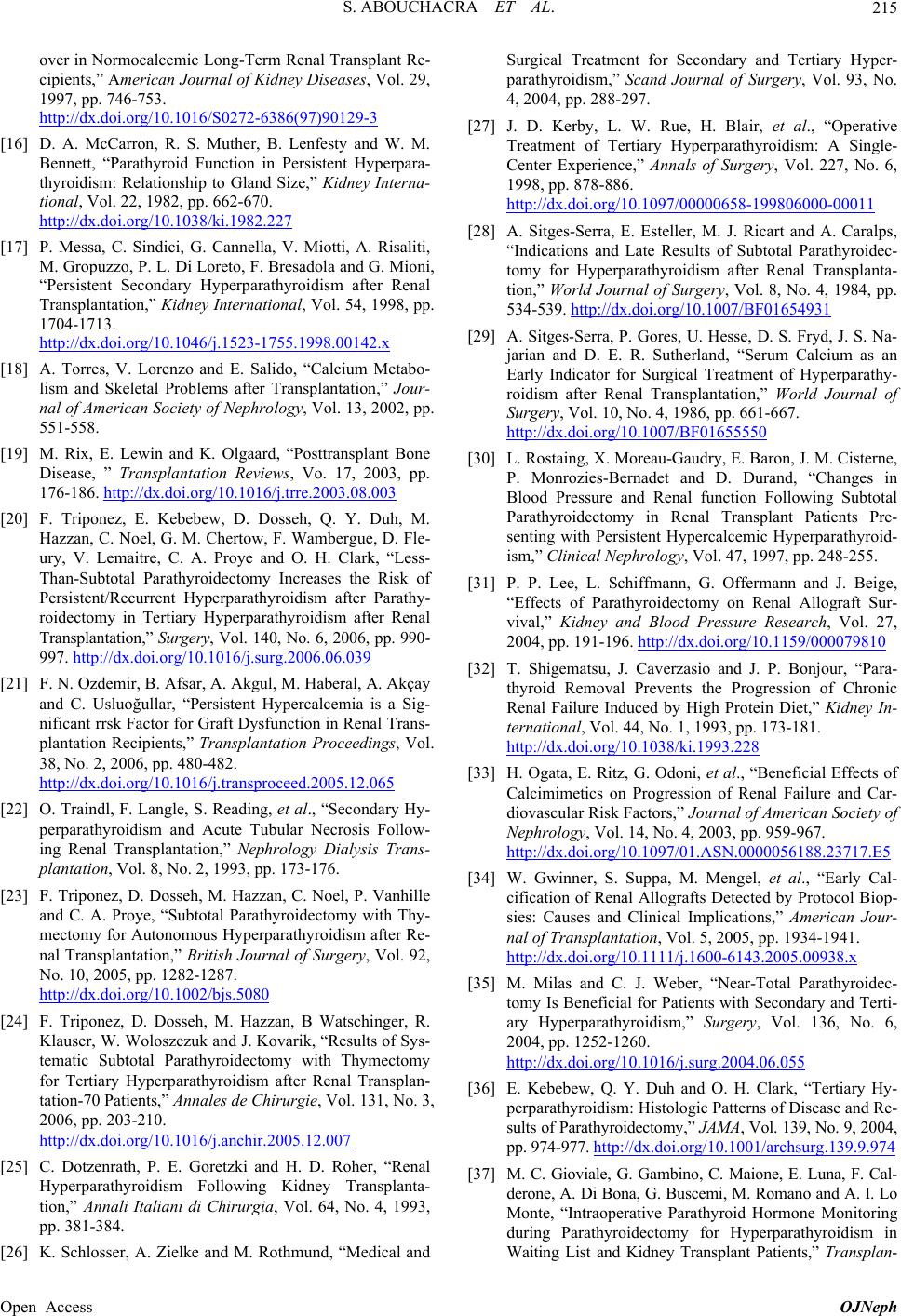 S. ABOUCHACRA ET AL. 215 over in Normocalcemic Long-Term Renal Transplant Re- cipients,” American Journal of Kidney Diseases, Vol. 29, 1997, pp. 746-753. http://dx.doi.org/10.1016/S0272-6386(97)90129-3 [16] D. A. McCarron, R. S. Muther, B. Lenfesty and W. M. Bennett, “Parathyroid Function in Persistent Hyperpara- thyroidism: Relationship to Gland Size,” Kidney Interna- tional, Vol. 22, 1982, pp. 662-670. http://dx.doi.org/10.1038/ki.1982.227 [17] P. Messa, C. Sindici, G. Cannella, V. Miotti, A. Risaliti, M. Gropuzzo, P. L. Di Loreto, F. Bresadola and G. Mioni, “Persistent Secondary Hyperparathyroidism after Renal Transplantation,” Kidney International, Vol. 54, 1998, pp. 1704-1713. http://dx.doi.org/10.1046/j.1523-1755.1998.00142.x [18] A. Torres, V. Lorenzo and E. Salido, “Calcium Metabo- lism and Skeletal Problems after Transplantation,” Jour- nal of American Society of Nephrology, Vol. 13, 2002, pp. 551-558. [19] M. Rix, E. Lewin and K. Olgaard, “Posttransplant Bone Disease, ” Transplantation Reviews, Vo. 17, 2003, pp. 176-186. http://dx.doi.org/10.1016/j.trre.2003.08.003 [20] F. Triponez, E. Kebebew, D. Dosseh, Q. Y. Duh, M. Hazzan, C. Noel, G. M. Chertow, F. Wambergue, D. Fle- ury, V. Lemaitre, C. A. Proye and O. H. Clark, “Less- Than-Subtotal Parathyroidectomy Increases the Risk of Persistent/Recurrent Hyperparathyroidism after Parathy- roidectomy in Tertiary Hyperparathyroidism after Renal Transplantation,” Surgery, Vol. 140, No. 6, 2006, pp. 990- 997. http://dx.doi.org/10.1016/j.surg.2006.06.039 [21] F. N. Ozdemir, B. Afsar, A. Akgul, M. Haberal, A. Akçay and C. Usluoğullar, “Persistent Hypercalcemia is a Sig- nificant rrsk Factor for Graft Dysfunction in Renal Trans- plantation Recipients,” Transplantation Proceedings, Vol. 38, No. 2, 2006, pp. 480-482. http://dx.doi.org/10.1016/j.transproceed.2005.12.065 [22] O. Traindl, F. Langle, S. Reading, et al., “Secondary Hy- perparathyroidism and Acute Tubular Necrosis Follow- ing Renal Transplantation,” Nephrology Dialysis Trans- plantation, Vol. 8, No. 2, 1993, pp. 173-176. [23] F. Triponez, D. Dosseh, M. Hazzan, C. Noel, P. Vanhille and C. A. Proye, “Subtotal Parathyroidectomy with Thy- mectomy for Autonomous Hyperparathyroidism after Re- nal Transplantation,” British Journal of Surgery, Vol. 92, No. 10, 2005, pp. 1282-1287. http://dx.doi.org/10.1002/bjs.5080 [24] F. Triponez, D. Dosseh, M. Hazzan, B Watschinger, R. Klauser, W. Woloszczuk and J. Kovarik, “Results of Sys- tematic Subtotal Parathyroidectomy with Thymectomy for Tertiary Hyperparathyroidism after Renal Transplan- tation-70 Patients,” Annales de Chirurgie, Vol. 131, No. 3, 2006, pp. 203-210. http://dx.doi.org/10.1016/j.anchir.2005.12.007 [25] C. Dotzenrath, P. E. Goretzki and H. D. Roher, “Renal Hyperparathyroidism Following Kidney Transplanta- tion,” Annali Italiani di Chirurgia, Vol. 64, No. 4, 1993, pp. 381-384. [26] K. Schlosser, A. Zielke and M. Rothmund, “Medical and Surgical Treatment for Secondary and Tertiary Hyper- parathyroidism,” Scand Journal of Surgery, Vol. 93, No. 4, 2004, pp. 288-297. [27] J. D. Kerby, L. W. Rue, H. Blair, et al., “Operative Treatment of Tertiary Hyperparathyroidism: A Single- Center Experience,” Annals of Surgery, Vol. 227, No. 6, 1998, pp. 878-886. http://dx.doi.org/10.1097/00000658-199806000-00011 [28] A. Sitges-Serra, E. Esteller, M. J. Ricart and A. Caralps, “Indications and Late Results of Subtotal Parathyroidec- tomy for Hyperparathyroidism after Renal Transplanta- tion,” World Journal of Surgery, Vol. 8, No. 4, 1984, pp. 534-539. http://dx.doi.org/10.1007/BF01654931 [29] A. Sitges-Serra, P. Gores, U. Hesse, D. S. Fryd, J. S. Na- jarian and D. E. R. Sutherland, “Serum Calcium as an Early Indicator for Surgical Treatment of Hyperparathy- roidism after Renal Transplantation,” World Journal of Surgery, Vol. 10, No. 4, 1986, pp. 661-667. http://dx.doi.org/10.1007/BF01655550 [30] L. Rostaing, X. Moreau-Gaudry, E. Baron, J. M. Cisterne, P. Monrozies-Bernadet and D. Durand, “Changes in Blood Pressure and Renal function Following Subtotal Parathyroidectomy in Renal Transplant Patients Pre- senting with Persistent Hypercalcemic Hyperparathyroid- ism,” Clinical Nephrology, Vol. 47, 1997, pp. 248-255. [31] P. P. Lee, L. Schiffmann, G. Offermann and J. Beige, “Effects of Parathyroidectomy on Renal Allograft Sur- vival,” Kidney and Blood Pressure Research, Vol. 27, 2004, pp. 191-196. http://dx.doi.org/10.1159/000079810 [32] T. Shigematsu, J. Caverzasio and J. P. Bonjour, “Para- thyroid Removal Prevents the Progression of Chronic Renal Failure Induced by High Protein Diet,” Kidney In- ternational, Vol. 44, No. 1, 1993, pp. 173-181. http://dx.doi.org/10.1038/ki.1993.228 [33] H. Ogata, E. Ritz, G. Odoni, et al., “Beneficial Effects of Calcimimetics on Progression of Renal Failure and Car- diovascular Risk Factors,” Journal of American Society of Nephrology, Vol. 14, No. 4, 2003, pp. 959-967. http://dx.doi.org/10.1097/01.ASN.0000056188.23717.E5 [34] W. Gwinner, S. Suppa, M. Mengel, et al., “Early Cal- cification of Renal Allografts Detected by Protocol Biop- sies: Causes and Clinical Implications,” American Jour- nal of Transplantation, Vol. 5, 2005, pp. 1934-1941. http://dx.doi.org/10.1111/j.1600-6143.2005.00938.x [35] M. Milas and C. J. Weber, “Near-Total Parathyroidec- tomy Is Beneficial for Patients with Secondary and Terti- ary Hyperparathyroidism,” Surgery, Vol. 136, No. 6, 2004, pp. 1252-1260. http://dx.doi.org/10.1016/j.surg.2004.06.055 [36] E. Kebebew, Q. Y. Duh and O. H. Clark, “Tertiary Hy- perparathyroidism: Histologic Patterns of Disease and Re- sults of Parathyroidectomy,” JAMA, Vol. 139, No. 9, 2004, pp. 974-977. http://dx.doi.org/10.1001/archsurg.139.9.974 [37] M. C. Gioviale, G. Gambino, C. Maione, E. Luna, F. Cal- derone, A. Di Bona, G. Buscemi, M. Romano and A. I. Lo Monte, “Intraoperative Parathyroid Hormone Monitoring during Parathyroidectomy for Hyperparathyroidism in Waiting List and Kidney Transplant Patients,” Transplan- Open Access OJNeph 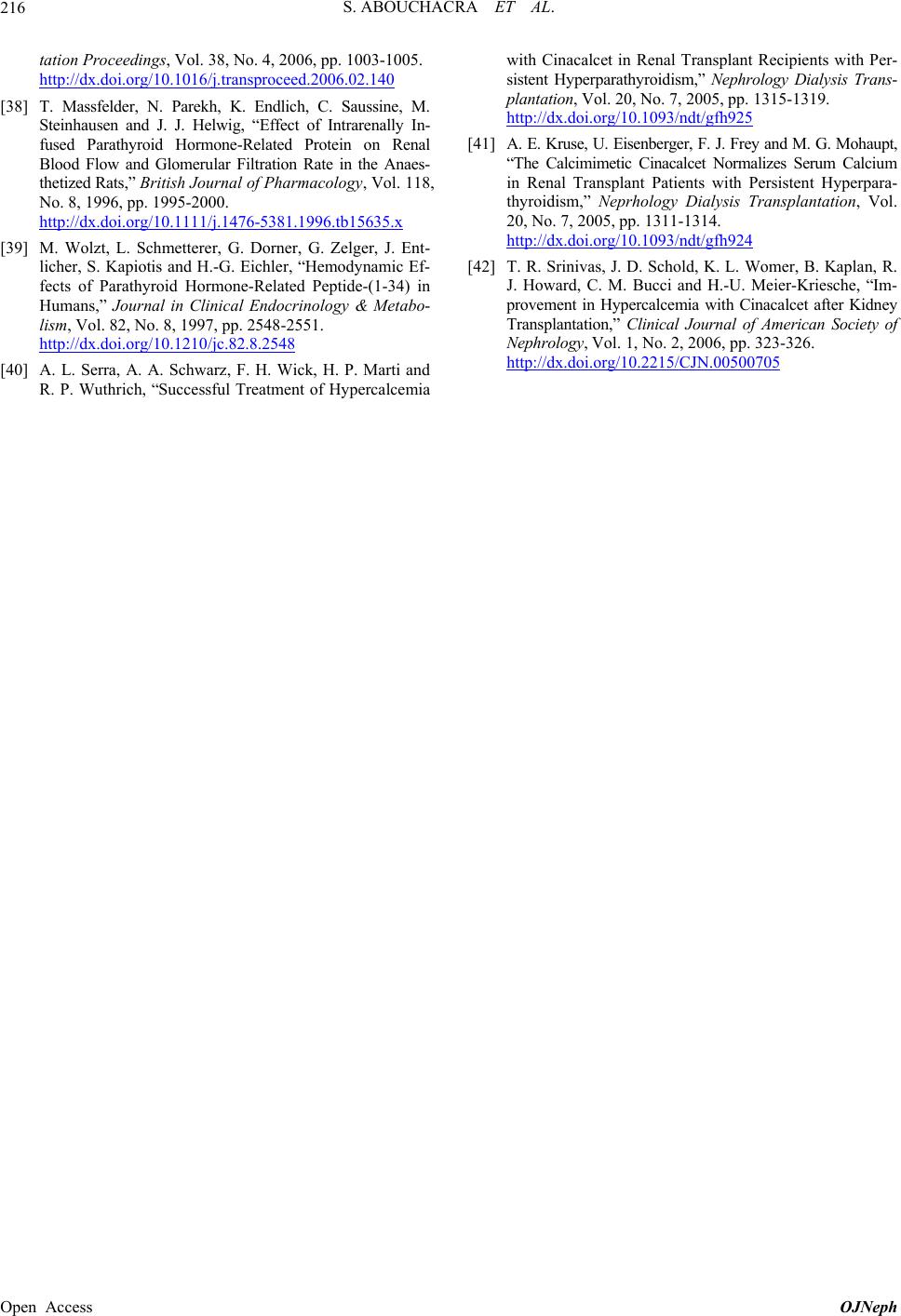 S. ABOUCHACRA ET AL. Open Access OJNeph 216 tation Proceedin g s, Vol. 38, No. 4, 2006, pp. 1003-1005. http://dx.doi.org/10.1016/j.transproceed.2006.02.140 [38] T. Massfelder, N. Parekh, K. Endlich, C. Saussine, M. Steinhausen and J. J. Helwig, “Effect of Intrarenally In- fused Parathyroid Hormone-Related Protein on Renal Blood Flow and Glomerular Filtration Rate in the Anaes- thetized Rats,” British Journal of Pharmacology, Vol. 118, No. 8, 1996, pp. 1995-2000. http://dx.doi.org/10.1111/j.1476-5381.1996.tb15635.x [39] M. Wolzt, L. Schmetterer, G. Dorner, G. Zelger, J. Ent- licher, S. Kapiotis and H.-G. Eichler, “Hemodynamic Ef- fects of Parathyroid Hormone-Related Peptide-(1-34) in Humans,” Journal in Clinical Endocrinology & Metabo- lism, Vol. 82, No. 8, 1997, pp. 2548-2551. http://dx.doi.org/10.1210/jc.82.8.2548 [40] A. L. Serra, A. A. Schwarz, F. H. Wick, H. P. Marti and R. P. Wuthrich, “Successful Treatment of Hypercalcemia with Cinacalcet in Renal Transplant Recipients with Per- sistent Hyperparathyroidism,” Nephrology Dialysis Trans- plantation, Vol. 20, No. 7, 2005, pp. 1315-1319. http://dx.doi.org/10.1093/ndt/gfh925 [41] A. E. Kruse, U. Eisenberger, F. J. Frey and M. G. Mohaupt, “The Calcimimetic Cinacalcet Normalizes Serum Calcium in Renal Transplant Patients with Persistent Hyperpara- thyroidism,” Neprhology Dialysis Transplantation, Vol. 20, No. 7, 2005, pp. 1311-1314. http://dx.doi.org/10.1093/ndt/gfh924 [42] T. R. Srinivas, J. D. Schold, K. L. Womer, B. Kaplan, R. J. Howard, C. M. Bucci and H.-U. Meier-Kriesche, “Im- provement in Hypercalcemia with Cinacalcet after Kidney Transplantation,” Clinical Journal of American Society of Nephrology, Vol. 1, No. 2, 2006, pp. 323-326. http://dx.doi.org/10.2215/CJN.00500705
|